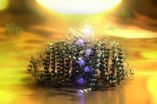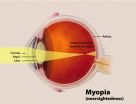(Press-News.org) This press release is available in German.
A team of scientists, led by Joachim Reichert, Johannes Barth, and Alexander Holleitner (Technische Universitaet Muenchen, Clusters of Excellence MAP and NIM), and Itai Carmeli (Tel Aviv University) developed a method to measure photocurrents of a single functionalized photosynthetic protein system. The scientists could demonstrate that such a system can be integrated and selectively addressed in artificial photovoltaic device architectures while retaining their biomolecular functional properties. The proteins represent light-driven, highly efficient single-molecule electron pumps that can act as current generators in nanoscale electric circuits. The interdisciplinary team publishes the results in ´Nature Nanotechnology´ this week.
The scientist investigated the photosystem-I reaction center which is a chlorophyll protein complex located in membranes of chloroplasts from cyanobacteria. Plants, algae and bacteria use photosynthesis to convert solar energy into chemical energy. The initial stages of this process – where light is absorbed and energy and electrons are transferred – are mediated by photosynthetic proteins composed of chlorophyll and carotenoid complexes. Until now, none of the available methods were sensitive enough to measure photocurrents generated by a single protein. Photosystem-I exhibits outstanding optoelectronic properties found only in photosynthetic systems. The nanoscale dimension further makes the photosystem-I a promising unit for applications in molecular optoelectronics.
The first challenge the physicists had to master was the development of a method to electrically contact single molecules in strong optical fields. The central element of the realized nanodevice are photosynthetic proteins self-assembled and covalently bound to a gold electrode via cysteine mutation groups. The photocurrent was measured by means of a gold-covered glass tip employed in a scanning near-field optical microscopy set-up. The photosynthetic proteins are optically excited by a photon flux guided through the tetrahedral tip that at the same time provides the electrical contact. With this technique, the physicists were able to monitor the photocurrent generated in single protein units.
INFORMATION:
The research was supported by the German Research Foundation (DFG) via the SPP 1243 (grants HO 3324/2 and RE 2592/2), the Clusters of Excellence Munich-Centre for Advanced Photonics and Nanosystems Initiative Munich, as well as ERC Advanced Grant MolArt (no. 47299).
Original publication:
Photocurrent of a single photosynthetic protein
Daniel Gerster, Joachim Reichert, Hai Bi, Johannes V. Barth, Simone M. Kaniber, Alexander W. Holleitner, Iris Visoly-Fisher, Shlomi Sergani, and Itai Carmeli
nature nanotechnology, Sept. 30, 2012 – DOI: 10.1038/nnano.2012.165
Solar cell consisting of a single molecule
Individual protein complex generates electric current
2012-10-02
ELSE PRESS RELEASES FROM THIS DATE:
Specialty contact lenses may one day help halt the progression of nearsightedness in children
2012-10-02
WASHINGTON, Oct. 2—Nearsightedness, or myopia, affects more than 40 percent of people in the U.S. and up to 90 percent of children in some parts of Asia. The problem begins in childhood and often progresses with age. Standard prescription lenses can correct the defocus but do not cure nearsightedness, and do not slow progression rates as children grow. But recent experimental work by biomedical scientist David Troilo and colleagues at the State University of New York (SUNY) College of Optometry in New York City supports the development of a potential cure for myopia by ...
3-D medical scanner: New handheld imaging device to aid doctors on the 'diagnostic front lines'
2012-10-02
WASHINGTON, Oct. 2, 2012—In the operating room, surgeons can see inside the human body in real time using advanced imaging techniques, but primary care physicians, the people who are on the front lines of diagnosing illnesses, haven't commonly had access to the same technology – until now. Engineers from the University of Illinois at Urbana-Champaign (UIUC) have created a new imaging tool for primary care physicians: a handheld scanner that would enable them to image all the sites they commonly examine, and more, such as bacterial colonies in the middle ear in 3-D, or monitor ...
Sea Education Association tall ship departs on major marine debris research cruise
2012-10-02
(San Diego, California – October 2, 2012) A tall ship owned and operated by Sea Education Association (SEA) will depart port tomorrow on a research expedition dedicated to examining the effects of plastic marine debris, including debris generated by the 2011 Japanese tsunami, in the ocean ecosystem.
During their 37-day cruise, the crew of the Woods Hole, Mass.-based sailing oceanographic research vessel Robert C. Seamans will explore a region between San Diego and Honolulu, popularly dubbed the "Great Pacific Garbage Patch", where high concentrations of plastic debris ...
RI Hospital: Differences in diagnosis, treatment of nonepileptic seizures in US, Chile
2012-10-02
PROVIDENCE, R.I. – Epileptic and psychogenic nonepileptic seizures (PNES) may look similar, but actually have different causes and treatments. Up to 20 percent of patients diagnosed with epilepsy actually have PNES, which are not treated by antiepileptic drugs (AEDs). According to a new study by Rhode Island Hospital researcher W. Curt LaFrance Jr., M.D., M.P.H., director of neuropsychiatry and behavioral neurology, increasing access to video electroencephalography (video-EEG) may aid in distinguishing between epilepsy and PNES. The study is published online in advance ...
Gene responsible for many spontaneous breast cancers identified
2012-10-02
BETHESDA, MD – October 2, 2012 -- Cancerous tumors contain hundreds of mutations, and finding these mutations that result in uncontrollable cell growth is like finding the proverbial needle in a haystack. As difficult as this task is, it's exactly what a team of scientists from Cornell University, the University of North Carolina, and Memorial Sloan-Kettering Cancer Center in New York have done for one type of breast cancer. In a report appearing in the journal GENETICS, researchers show that mutations in a gene called NF1 are prevalent in more than one-fourth of all noninheritable ...
Amazonian tribal warfare sheds light on modern violence, says MU anthropologist
2012-10-02
In the tribal societies of the Amazon forest, violent conflict accounted for 30 percent of all deaths before contact with Europeans, according to a recent study by University of Missouri anthropologist Robert Walker. Understanding the reasons behind those altercations in the Amazon sheds light on the instinctual motivations that continue to drive human groups to violence, as well as the ways culture influences the intensity and frequency of violence.
"The same reasons - revenge, honor, territory and jealousy over women - that fueled deadly conflicts in the Amazon continue ...
Manatees reflect quality of health in marine ecosystems, longterm study finds
2012-10-02
FAIRFAX, Va., October 1, 2012—A longterm study conducted by researchers at George Mason University may be a benchmark in determining health threats to marine mammals.
Over ten years of research in Belize was conducted studying the behavioral ecology, life history and health of manatees in an area relatively undisturbed by humankind.
"Manatees are the proverbial 'canaries in the mineshaft,' as they serve as indicators of their environment and may reflect the overall health of marine ecosystems," says Alonso Aguirre, executive director of the Smithsonian-Mason School ...
Adult stem cells change their epigenome to generate new organs
2012-10-02
The team led by Manel Esteller, director of the Cancer Epigenetics and Biology Program in the Bellvitge Biomedical Research Institute (IDIBELL), Professor of Genetics at the University of Barcelona and ICREA researcher, has identified epigenetic changes that occur in adult stem cells to generate different body tissues. The finding is published this week in The American Journal of Pathology.
The genome of every single cell in the human body is the same, regardless of their appearance and function. Therefore the activity of the tissues and organs and its disorders in complex ...
Hopkins study suggests treatments for 'wet' AMD keep elderly drivers behind the wheel
2012-10-02
The advanced neovascular, or "wet," form of age-related macular degeneration (AMD), left untreated, is the most common cause of vision loss among the elderly and a leading reason for their loss of driving privileges. But results of a new study, published in the online version of the journal Ophthalmology, suggest that monthly injections of ranibizumab improve eye chart test results required for a driver's license, build driver confidence and keep those with AMD driving longer.
The wet form of AMD is marked by the abnormal scarring and leaking of new blood vessels in ...
New findings on the workings of the inner ear
2012-10-02
The sensory cells of the inner ear have tiny hairs called stereocilia that play a critical part in hearing. It has long been known that these stereocilia move sideways back and forth in a wave-like motion when stimulated by a sound wave. After having designed a microscope to observe these movements, a research team at Karolinska Institutet in Sweden has discovered that the hairs not only move sideways but also change in length.
The discovery, which was made in collaboration with scientists at Baylor College of Medicine in Texas, USA provides new fundamental knowledge ...
LAST 30 PRESS RELEASES:
Young adults commonly mix cannabis with nicotine and tobacco
Comprehensive review illuminates tau protein's dual nature in brain health, disease, and emerging psychiatric connections
Book prepares K-12 leaders for the next public health crisis
Storms in the Southern Ocean mitigates global warming
Seals on the move: Research reveals key data for offshore development and international ecology
Sports injuries sustained during your period might be more severe
World's first successful 2 Tbit/s free-space optical communication using small optical terminals mountable on satellites and HAPS
Can intimate relationships affect your heart? New study says ‘yes’
Scalable and healable gradient textiles for multi‑scenario radiative cooling via bicomponent blow spinning
Research shows informed traders never let a good climate crisis go to waste
Intelligent XGBoost framework enhances asphalt pavement skid resistance assessment
Dual-function biomaterials for postoperative osteosarcoma: Tumor suppression and bone regeneration
New framework reveals where transport emissions concentrate in Singapore
NTP-enhanced lattice oxygen activation in Ce-Co catalysts for low-temperature soot combustion
Synergistic interface engineering in Cu-Zn-Ce catalysts for efficient CO2 hydrogenation to methanol
COVID-19 leaves a lasting mark on the human brain
Scientists use ultrasound to soften and treat cancer tumors without damaging healthy tissue
Community swimming program for Black youth boosts skills, sense of belonging, study finds
Specific depressive symptoms in midlife linked to increased dementia risk
An ‘illuminating’ design sheds light on cholesterol
Who is more likely to get long COVID?
Study showcases resilience and rapid growth of “living rocks”
Naval Research Lab diver earns Office of Naval Research 2025 Sailor of the Year
New Mayo-led study establishes practical definition for rapidly progressive dementia
Fossil fuel industry’s “climate false solutions” reinforce its power and aggravate environmental injustice
Researchers reveal bias in a widely used measure of algorithm performance
Alcohol causes cancer. A study from IOCB Prague confirms damage to DNA and shows how cells defend against it
Hidden viruses in wastewater treatment may shape public health risks, study finds
Unlock the power of nature: how biomass can transform climate mitigation
Biochar reshapes hidden soil microbes that capture carbon dioxide in farmland
[Press-News.org] Solar cell consisting of a single moleculeIndividual protein complex generates electric current


